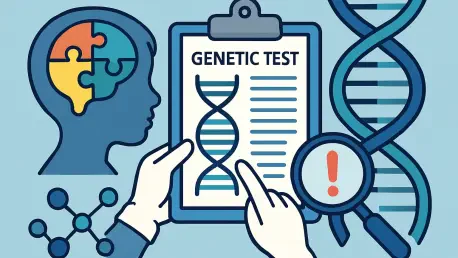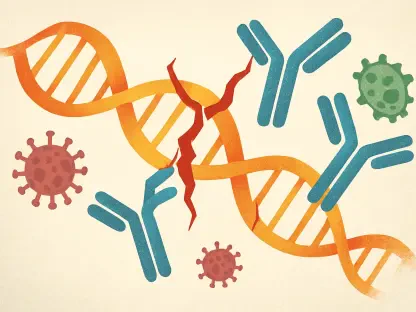Autism Spectrum Disorder (ASD) has traditionally been understood as a condition manifesting in early childhood, yet a pioneering study from the University of Cambridge is turning this perspective on its head with revelations about the genetic and developmental differences tied to the timing of diagnosis. This extensive research, encompassing over 45,000 autistic individuals from regions including the UK, Australia, Europe, and the US, uncovers that whether autism is diagnosed early—typically before the age of six—or later in life during adolescence or beyond, it reflects unique biological underpinnings. Far from being a uniform disorder, autism emerges as a complex spectrum where the age of diagnosis signals distinct genetic profiles and developmental paths. This groundbreaking insight not only challenges conventional views but also sparks curiosity about how such differences could transform approaches to identifying and supporting autistic individuals across their lifespans. What might this mean for those who slip through the cracks of early detection, and how can science bridge these gaps?
The implications of this research ripple through the fields of neuroscience and clinical practice, urging a reevaluation of diagnostic tools and support mechanisms to better address the diverse needs of individuals with autism. Early diagnoses often arise from overt social and behavioral challenges noticeable in young children, while late diagnoses may stem from subtler issues that become apparent only as social demands intensify with age. These variations suggest that the timing of recognition is not merely a matter of oversight but a reflection of deeper, inherent differences. By delving into vast datasets of genetic and behavioral information, the study provides a clearer picture of why autism presents so differently across individuals and life stages. This raises pivotal questions about the adequacy of current screening methods, often designed with young children in mind, and whether they fail to capture the nuances of autism in older individuals. As the understanding of autism evolves, the need for tailored strategies becomes ever more pressing to ensure that no one is left behind due to the limitations of existing frameworks.
Genetic Foundations of Autism Diagnoses
Uncovering Distinct Genetic Blueprints
The University of Cambridge study reveals a striking divergence in the genetic architecture associated with early and late autism diagnoses, offering a fresh lens on the condition’s complexity. For individuals diagnosed before age six, the genetic patterns identified differ significantly from those recognized in late childhood or adolescence, with only a limited overlap between the two groups. This suggests that the biological foundations of autism are not uniform but vary depending on when symptoms become evident. Such findings challenge the long-standing assumption that autism stems from a single set of genetic factors, pointing instead to a mosaic of influences that shape its expression over time. The research underscores that these genetic distinctions are not trivial; they may hold the key to understanding why some autistic traits are apparent early on while others remain hidden until later developmental stages, prompting a need for more nuanced genetic screening approaches.
Further exploration into these genetic profiles highlights a particularly intriguing aspect of late-diagnosed autism: a closer resemblance to other neurodevelopmental and mental health conditions such as ADHD, depression, and PTSD. This overlap hints at shared biological pathways that could influence not only the timing of an autism diagnosis but also the co-occurrence of additional challenges. Unlike early-diagnosed individuals, whose genetic markers are more uniquely tied to classic autism traits, those identified later in life appear to carry a broader spectrum of genetic risks that intersect with other psychiatric conditions. This discovery suggests that late-diagnosed autism might represent a distinct subtype within the spectrum, necessitating diagnostic tools that account for these overlapping genetic signatures. It also raises the possibility that interventions targeting shared mechanisms could address multiple conditions simultaneously, offering a more integrated approach to care for those diagnosed in adolescence or adulthood.
Polygenic Contributions to Diagnosis Timing
Delving deeper into the genetic data, the study estimates that polygenic factors—combinations of numerous small genetic variations—account for approximately 11% of the variation in the age at which autism is diagnosed. This contribution is comparable to the impact of sociodemographic and clinical factors, which collectively explain less than 15% of such variance. The significance of this finding lies in its demonstration that genetic predispositions play a substantial role in determining when autism becomes recognizable, challenging the notion that timing is purely a matter of environmental or social circumstances. These polygenic influences suggest that the biological underpinnings of autism are intricately tied to developmental windows, where certain genetic variants may trigger earlier or later emergence of symptoms. This insight calls for a shift in research focus toward identifying specific genetic markers that correlate with diagnosis timing, potentially enhancing predictive models for autism detection.
Moreover, the identification of polygenic factors as a key driver of diagnosis timing opens new avenues for understanding the spectrum’s diversity. While early-diagnosed individuals may exhibit genetic variants that prompt rapid manifestation of social and communication difficulties, those diagnosed later might carry variants that interact more subtly with developmental and environmental triggers over time. This nuanced interplay indicates that autism cannot be reduced to a singular genetic profile but must be viewed as a dynamic condition shaped by a multitude of small genetic effects. Such complexity underscores the importance of large-scale genetic studies to map these variations comprehensively. By doing so, clinicians could one day tailor diagnostic and therapeutic strategies based on an individual’s unique genetic makeup, ensuring that interventions are both timely and effective, regardless of when autism is first identified.
Developmental Trajectories and Diagnosis Timing
Behavioral Manifestations Across Ages
One of the most compelling aspects of the University of Cambridge research is the clear distinction in behavioral patterns between early and late autism diagnoses, reflecting how autism unfolds across different life stages. For those diagnosed before the age of six, social and communication challenges often present themselves vividly in early childhood, becoming noticeable to parents and caregivers through difficulties in forming connections or engaging in typical play. These pronounced traits frequently lead to prompt evaluations, as the deviations from expected developmental milestones are hard to overlook. The early visibility of such challenges suggests that autism in these individuals follows a more overt trajectory, where core symptoms align closely with traditional diagnostic criteria designed for young children. This raises the question of whether current frameworks are sufficiently equipped to capture the full range of autism’s expressions beyond these early years, or if they inadvertently prioritize a specific developmental window.
In contrast, individuals diagnosed later—often during late childhood or adolescence—tend to exhibit difficulties that emerge or intensify as they navigate more complex social environments. These challenges might not have been apparent in early years, either due to subtler symptoms or compensatory strategies that mask underlying struggles. As social expectations grow with age, such as the need for nuanced peer interactions or academic pressures, these individuals may find it harder to cope, leading to behaviors or emotional responses that finally prompt a diagnosis. This delayed recognition highlights a critical gap in how autism is perceived and detected, suggesting that many may go unsupported for years simply because their symptoms do not fit the early childhood mold. The study emphasizes that these later-emerging traits are no less significant, urging a broader understanding of autism that accounts for its potential to surface at any stage of life, and calls for diagnostic tools that adapt to these shifting manifestations.
Long-Term Developmental Impacts
The timing of an autism diagnosis carries profound implications for long-term developmental outcomes, as the study reveals distinct trajectories shaped by when challenges are first identified. Early-diagnosed individuals often benefit from interventions initiated during critical developmental periods, potentially mitigating some of the social and behavioral difficulties they face. Access to therapies or educational support at a young age can help build foundational skills, such as communication or emotional regulation, which may influence their ability to navigate future challenges. However, even with early recognition, the persistence of certain traits suggests that autism remains a lifelong condition requiring ongoing adaptation. This trajectory underscores the importance of sustained support beyond initial interventions, ensuring that early-diagnosed individuals continue to receive resources as their needs evolve through adolescence and into adulthood.
On the other hand, those diagnosed later often face a different set of developmental hurdles, compounded by years of unrecognized needs that can significantly impact their growth and well-being. Without early support, these individuals may develop coping mechanisms that are less adaptive, or they might internalize struggles in ways that affect their self-esteem and social integration over time. The study points out that the delay in diagnosis can lead to a cascade of secondary issues, such as academic underachievement or strained relationships, which become harder to address as time progresses. This trajectory illustrates the urgent need for systems that can identify autism beyond early childhood, ensuring that late-diagnosed individuals are not left to navigate their challenges alone for extended periods. By recognizing these varied developmental paths, the research advocates for a more flexible approach to autism care, one that prioritizes timely identification and personalized support at any age to optimize long-term outcomes.
Impact of Environment and Support Systems
Mental Health Challenges and Delayed Recognition
A significant finding from the research is the elevated risk of mental health conditions, particularly depression, among individuals diagnosed with autism later in life, a risk driven by a combination of genetic predispositions and environmental factors. For those who go undiagnosed in early childhood, the absence of tailored support often means facing social and emotional challenges without adequate resources or understanding. This can lead to feelings of isolation or inadequacy, especially as they encounter increasing societal expectations in adolescence or adulthood. The study suggests that these mental health struggles are not merely coincidental but are deeply intertwined with the lack of early intervention, which could otherwise buffer against such outcomes. This connection highlights a critical oversight in current systems, where the focus on early detection may inadvertently neglect those whose autism manifests differently, leaving them vulnerable to additional psychological burdens.
Furthermore, the impact of delayed recognition on mental health extends beyond individual experiences to broader social dynamics, as noted in the research. Late-diagnosed individuals are more likely to encounter negative peer interactions, such as bullying, due to unrecognized differences in social processing or behavior. These adverse experiences can compound stress and anxiety, contributing to a higher prevalence of conditions like depression or PTSD, which the study links genetically to late-diagnosed autism. This overlap suggests that mental health challenges are not just a consequence of autism but may share common biological roots, amplified by a lack of supportive environments. Addressing this issue requires a dual approach: enhancing diagnostic reach to identify autism at any age and fostering inclusive settings that reduce stigma and misunderstanding. Without such measures, the mental health toll on late-diagnosed individuals risks becoming a persistent barrier to their well-being and integration.
Role of Early Intervention and Social Support
The protective power of early intervention emerges as a crucial theme in the study, illustrating how timely support can alter the trajectory for autistic individuals, particularly in mitigating mental health risks. When autism is identified early, access to therapies, educational accommodations, and family guidance can equip individuals with tools to navigate social and behavioral challenges more effectively. These interventions often focus on building communication skills or managing sensory sensitivities, which can significantly reduce frustration and enhance quality of life during formative years. The research indicates that such support not only addresses immediate needs but also lays a foundation for resilience against future stressors. This preventive aspect of early intervention underscores the importance of robust screening programs that prioritize early detection, ensuring that potential difficulties are addressed before they escalate into more complex issues.
Equally important is the role of social support systems in shaping outcomes for both early- and late-diagnosed individuals, as highlighted by the study’s emphasis on environmental influences. Beyond clinical interventions, supportive family dynamics, inclusive educational environments, and community awareness play a pivotal role in buffering against the challenges associated with autism. For late-diagnosed individuals, who may have endured years of misunderstanding, targeted social support can be transformative, helping to rebuild confidence and foster connections that were previously strained. The research suggests that creating environments where differences are understood and accommodated can significantly alleviate the emotional toll of autism, regardless of the timing of diagnosis. This calls for broader societal efforts to educate communities and institutions about autism’s diverse presentations, ensuring that support is not just a clinical endeavor but a collective responsibility that enhances life outcomes across the spectrum.
Redefining Autism as a Spectrum of Conditions
Challenging the Uniform View of Autism
The University of Cambridge study marks a paradigm shift by challenging the traditional perception of autism as a singular, uniform condition, instead proposing that it encompasses multiple distinct conditions with varied genetic and developmental origins. This reconceptualization stems from the clear differences observed between early and late diagnoses, which suggest that autism does not follow a single biological or behavioral pathway. Researchers, including lead author Xinhe Zhang and senior author Dr. Varun Warrier, argue that viewing autism through a monolithic lens oversimplifies its complexity and risks overlooking critical nuances in how it manifests. This perspective urges a departure from standardized diagnostic criteria that may prioritize one expression of autism over others, advocating for a more inclusive framework that recognizes the spectrum’s true diversity. Such a shift could redefine how autism is studied and understood, moving toward a model that respects individual differences as fundamental to the condition.
Additionally, the idea of autism as a collection of conditions rather than a single disorder has far-reaching implications for both research and clinical practice, as the study suggests. By acknowledging that early- and late-diagnosed autism may represent distinct subtypes, scientists can better target their investigations into specific genetic mechanisms or developmental triggers associated with each. This approach could lead to the discovery of more precise biomarkers or risk factors, enhancing the ability to predict and identify autism across different life stages. Clinically, it means that interventions might need to be customized not just to an individual’s symptoms but also to the underlying subtype of autism they exhibit. The research calls for a reimagining of autism as a dynamic spectrum, where the focus shifts from fitting individuals into a predefined mold to understanding the unique biological and environmental factors that shape their experiences over time.
Personalized Approaches to Autism Care
Embracing autism as a spectrum of conditions naturally leads to the need for personalized approaches in diagnosis and care, a key takeaway from the research findings. Current diagnostic tools, often designed with early childhood behaviors in mind, may fail to capture the subtler or later-emerging signs that characterize many late diagnoses. Adapting these tools to account for age-specific manifestations could significantly improve detection rates, ensuring that individuals are not overlooked simply because their autism presents differently. The study suggests that incorporating genetic profiling into diagnostic processes might further refine accuracy, allowing clinicians to identify specific risk patterns tied to early or late onset. This tailored approach would not only enhance the precision of diagnoses but also ensure that subsequent support aligns more closely with an individual’s unique needs, maximizing its effectiveness across diverse presentations of autism.
Moreover, personalized care extends beyond diagnosis to the design of interventions and support systems, as emphasized by the research’s focus on individual variability. For early-diagnosed individuals, interventions might prioritize foundational skills like communication or social engagement, delivered during critical developmental windows. In contrast, late-diagnosed individuals may require support that addresses secondary challenges, such as mental health issues or social reintegration, alongside core autistic traits. The study highlights that understanding the genetic and developmental underpinnings of each diagnosis type can guide these tailored strategies, ensuring that resources are allocated where they are most needed. This move toward customization reflects a broader trend in neurodevelopmental research, where the goal is to shift from generic solutions to personalized plans that honor the spectrum’s complexity, ultimately improving outcomes for autistic individuals at every stage of life.
Implications for Diagnosis and Support
Enhancing Diagnostic Reach Across Ages
One of the most pressing implications of the University of Cambridge study is the need to enhance diagnostic reach to identify autism at all ages, addressing the limitations of frameworks that primarily target early childhood behaviors. Many late-diagnosed individuals slip through the cracks because their symptoms do not align with the classic presentation seen in young children, often leading to years of unrecognized struggles. The research suggests that expanding diagnostic criteria to include age-specific indicators—such as difficulties with complex social interactions in adolescence—could close this gap. Additionally, integrating genetic screening tools might offer a complementary method to detect underlying predispositions, even before behavioral signs become overt. This dual approach would ensure that autism is recognized regardless of when it emerges, preventing the delays that can exacerbate challenges and hinder access to vital support services over time.
Equally critical is the development of training programs for healthcare providers and educators to recognize the diverse ways autism can present beyond early childhood, as underscored by the study’s findings. Professionals often rely on outdated stereotypes or limited exposure to late-onset symptoms, which can result in missed diagnoses. By updating curricula and clinical guidelines to reflect the spectrum’s variability, the likelihood of identifying autism in older children, teens, and adults increases significantly. The research also points to the value of public health campaigns that educate families about autism’s later manifestations, empowering them to seek evaluations when subtle difficulties arise. Such efforts could transform the diagnostic landscape, ensuring that individuals receive timely recognition and intervention, regardless of their age. This comprehensive strategy aims to build a system where autism detection is not bound by developmental stage but adapts dynamically to the condition’s evolving nature.
Building Inclusive Support Mechanisms
Beyond improving diagnosis, the study emphasizes the urgent need to build inclusive support mechanisms that cater to the unique needs of both early- and late-diagnosed autistic individuals. For those identified early, support often focuses on immediate interventions like speech therapy or behavioral programs, which can be pivotal in shaping developmental outcomes. However, sustaining these resources into later years is equally important, as challenges may shift with age. The research suggests that creating lifelong support plans—ones that evolve with an individual’s changing needs—could prevent gaps in care that often occur during transitions, such as moving from school to adulthood. This continuity ensures that early-diagnosed individuals are not left without guidance as new social or professional demands emerge, maintaining their ability to thrive across different life stages.
For late-diagnosed individuals, the focus of support must address both the core traits of autism and the secondary effects of delayed recognition, as highlighted by the research. Tailored programs that tackle mental health issues, rebuild social confidence, and provide vocational training can make a significant difference for those who have navigated years without assistance. The study also advocates for community-based initiatives that foster acceptance and reduce stigma, creating environments where late-diagnosed individuals feel understood rather than marginalized. By combining clinical interventions with societal change, support mechanisms can become truly inclusive, addressing the spectrum’s diversity in a holistic manner. Looking ahead, the next steps involve policymakers, educators, and healthcare systems collaborating to implement these findings, ensuring that every autistic individual—regardless of when they are diagnosed—receives the resources and understanding needed to lead fulfilling lives.









